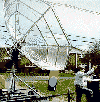delivered on 21 April 1996 by Dr. H. Paul Shuch
Executive Director, The SETI League, Inc.
 General Information
General Information
 We are here to launch a new Search for Extra-Terrestrial Intelligence. We seek to determine whether
humankind is alone, the sole sentient species in the vast cosmos. The late NASA SETI program, terminated by
Congress two and a half years ago, involved a two-pronged approach to answering that question. A targeted
search of nearby Suns was designed to offer prompt results -- if we happen to guess right as to what constitutes
a suitable star. But just in case we don't, a methodical survey of the entire sky was also begun. Our SETI Institute colleagues in California have very ably resurrected the targeted search component, under the Project Phoenix banner. Today, we begin Project Argus, our continuation of the sky survey. But we are attempting something which NASA had never contemplated: real-time, all-sky coverage.
We are here to launch a new Search for Extra-Terrestrial Intelligence. We seek to determine whether
humankind is alone, the sole sentient species in the vast cosmos. The late NASA SETI program, terminated by
Congress two and a half years ago, involved a two-pronged approach to answering that question. A targeted
search of nearby Suns was designed to offer prompt results -- if we happen to guess right as to what constitutes
a suitable star. But just in case we don't, a methodical survey of the entire sky was also begun. Our SETI Institute colleagues in California have very ably resurrected the targeted search component, under the Project Phoenix banner. Today, we begin Project Argus, our continuation of the sky survey. But we are attempting something which NASA had never contemplated: real-time, all-sky coverage. You see, the world's giant radio telescopes, the type which NASA used, can only see about a millionth of the sky at a time. Which means if you have one turned on, tuned to exactly the right frequency, at the very instant when The Call comes in, there's still a 99.9999% chance you'll be pointed the wrong way! One possible solution is to build a million such instruments, and cover the entire sky, all at once. At maybe fifty million dollars apiece, we'd very quickly exceed the Gross Planetary Product. But small radio telescopes such as this one can see 200 times as much sky as more traditional research instruments. Only five thousand of these systems, each priced at just a few thousand dollars, can be coordinated to see in all directions at once.
It's true that these small telescopes have limited sensitivity. Thus at this time we can only hope to capture those highly intermittent, extremely powerful radio emissions which we hypothesize might be emanating from relatively nearby technological civilizations. But our microwave and computer technologies are evolving at a dizzying pace. Within just a few years, we can envision technological advances which would allow instruments like this one to hear all the way to the edge of the Galaxy. The SETI League hopes to promote just such advances. If we do, then our mission is successful, even if we never hear a peep from the stars.
During the last half-century, SETI has emerged out of the realm of science fiction, and into the scientific mainstream. Every month we read about the discovery of yet another planetary system in space. We are beginning to learn about how life might have developed on other worlds. And we have completed the Copernican Revolution, finally realizing that we are not the center of all creation. Yet SETI programs continue to yield negative results. We are not discouraged. Not only have we not yet scratched the surface, we haven't even felt the itch.
We launch our search on Earth Day, and fly the Flag of Earth, because SETI is an enterprise which belongs not just to one country, government or organization, but rather to all humankind. Like Argus, the guard-beast of Greek mythology who had a hundred eyes, we seek to see in all directions at once, that we might capture those photons from distant worlds which may well be falling on our heads even as we speak. Today, Project Argus stations go on the air in Spain, Toronto, Colorado, Hawaii, and here in New Jersey. This small step for humanity represents a humble beginning for what will ultimately be a global effort. From five stations today, we can foresee 500 participants within two years, and perhaps five thousand by the year 2001. When we reach that level, there will be no direction in the sky which evades our gaze. Then we can hope to find the answer to a fundamental question which has haunted humankind since first we realized that the points of light in the night sky are other suns: Are We Alone?
email the Webmaster | entire website copyright © The SETI League, Inc. this page last updated 8 March 2003 |
Top of Page |